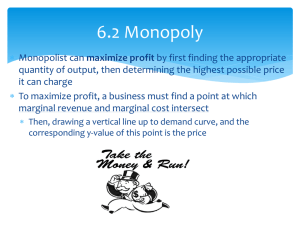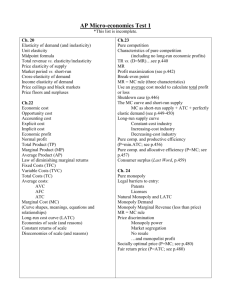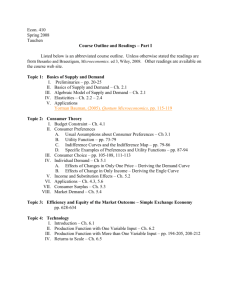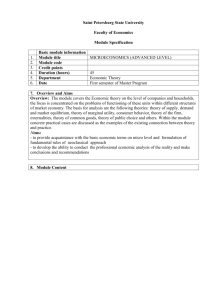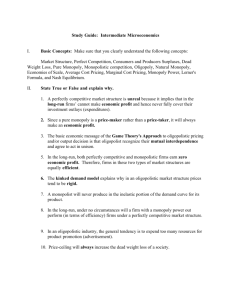Name: ___________________________ Unit IV: Imperfect Competition Problem Set #4
advertisement
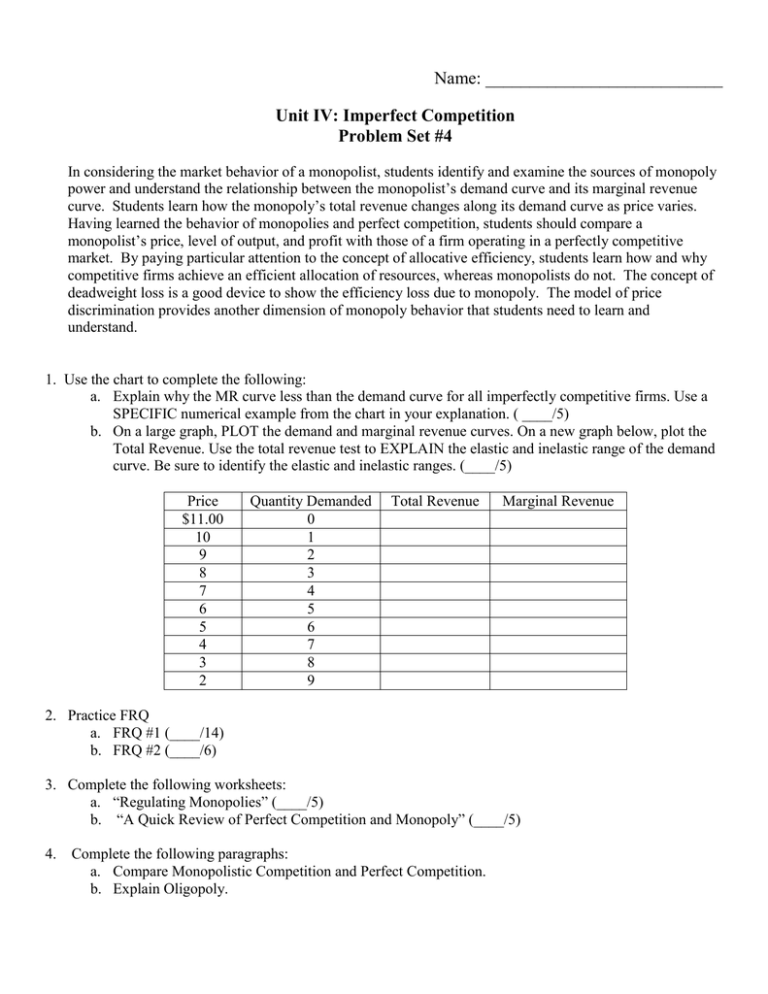
Name: ___________________________ Unit IV: Imperfect Competition Problem Set #4 In considering the market behavior of a monopolist, students identify and examine the sources of monopoly power and understand the relationship between the monopolist’s demand curve and its marginal revenue curve. Students learn how the monopoly’s total revenue changes along its demand curve as price varies. Having learned the behavior of monopolies and perfect competition, students should compare a monopolist’s price, level of output, and profit with those of a firm operating in a perfectly competitive market. By paying particular attention to the concept of allocative efficiency, students learn how and why competitive firms achieve an efficient allocation of resources, whereas monopolists do not. The concept of deadweight loss is a good device to show the efficiency loss due to monopoly. The model of price discrimination provides another dimension of monopoly behavior that students need to learn and understand. 1. Use the chart to complete the following: a. Explain why the MR curve less than the demand curve for all imperfectly competitive firms. Use a SPECIFIC numerical example from the chart in your explanation. ( ____/5) b. On a large graph, PLOT the demand and marginal revenue curves. On a new graph below, plot the Total Revenue. Use the total revenue test to EXPLAIN the elastic and inelastic range of the demand curve. Be sure to identify the elastic and inelastic ranges. (____/5) Price $11.00 10 9 8 7 6 5 4 3 2 Quantity Demanded 0 1 2 3 4 5 6 7 8 9 Total Revenue Marginal Revenue 2. Practice FRQ a. FRQ #1 (____/14) b. FRQ #2 (____/6) 3. Complete the following worksheets: a. “Regulating Monopolies” (____/5) b. “A Quick Review of Perfect Competition and Monopoly” (____/5) 4. Complete the following paragraphs: a. Compare Monopolistic Competition and Perfect Competition. b. Explain Oligopoly. 5. (_____/40 Points Total) Create a well-organized study guide that includes the essential concepts and graphs for each of the four market structures. Points will be awarded according to the following criteria: a. Overall Structure of the Study Guide i. Well organized information that is easily accessible (____/5) ii. Clear and well drawn graphs (____/5) b. Explanation of the following General Concepts: (____/5) i. Profit Maximizing Rule ii. Short-Run Supply Curve and Shut-down Point iii. Productive Efficiency iv. Allocative Efficiency v. Excess Capacity c. Graphs of Each of the Following: i. Costs of Production (____/6) 1. Production Function TP, MP, and AP (Graph with three stages) 2. TC, VC, FC (Definitions) 3. MC, ATC, AVC, AFC (Formulas and Graph) 4. Long-Run ATC (Graph showing Economies and Diseconomies of Scale) ii. Perfect Competition (____/5) 1. List Characteristics 2. Firm and Industry in Short-Run Making Profit (Graph) 3. Firm and Industry in Short-Run Making Loss (Graph) 4. Firm and Industry in Long-Run equilibrium (Graph) 5. How economic profit and loss disappear in the Long-Run (Graph) iii. Monopolies (____/5) 1. List Characteristics 2. Demand and MR for imperfectly competitive firms (Elastic and Inelastic range) 3. Monopoly making a profit (Graph-label Profit, Consumers Surplus, and DWL) 4. Perfectly Price Discriminating Monopoly (Graph) 5. Regulated Monopolies (Fair Return and Socially Optimal) iv. Monopolistic Competition (____/5) 1. List Characteristics 2. Firm Making Short-Run Profit (Graph) 3. Firm Making Short-Run Loss (Graph) 4. Firm in Long-Run Equilibrium (Graph) 5. How economic profit and loss disappear in the Long-Run (Graph) v. Oligopolies (____/4) 1. List Characteristics 2. Game-Theory Model (Matrix) 3. Kinked Demand Curve (Graph) 4. Profit maximization with Collusion (Graph)
